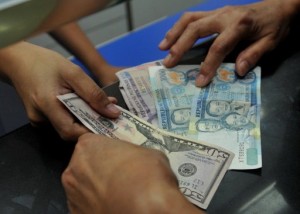Peso pulls back to 49.98:$1 after touching 50:$1
MANILA — The peso touched the 50:$1 level Thursday even as it closed at a fresh eight-year low of 49.98:$1.
At the Philippine Dealing System, the domestic currency hit an intraday low of 50:$1 and a high of 49.91:$1 after opening at 49.95:$1.
Thursday’s close continued the slide from Wednesday’s 49.86:$1.
The total volume traded rose to $437.6 million from $360.5 million last Wednesday.
“The Philippine peso’s breaching of the 50:$1 level is an expected reaction of the local currency to the anticipated early rate increase by the US Federal Reserve, with other Asian currencies also moving in the same direction,” Finance Secretary Carlos G. Dominguez III said in a statement.
Article continues after this advertisement“We are watching the currency movements very closely. We seem to be moving in the same direction as the other currencies. We just want to avoid abrupt changes in the exchange rates,” said Dominguez, who heads the Duterte administration’s economic team.
Article continues after this advertisementING Bank Manila senior economist Joey Cuyegkeng noted that “external pressures have become more dominant again.”
“These include expectations of not only higher US benchmark policy rate next month but also expectations that 2017 would also see another 50-basis point hike. Markets remain on edge over likely US trade and jobs policies and fiscal spending by next year. External risks also include Brexit negotiations, China’s growth and leverage concerns, and EU stability,” Cuyegkeng said.
Also, “the underlying political concerns remain as market participants are also cautious despite the relatively favorable economic fundamentals,” Cuyegkeng added, referring to protests scheduled Friday and next week against the hero’s burial for dictator Ferdinand Marcos on the domestic front, as well as the recent win of Donald Trump in the US presidential election.
The latest Bangko Sentral ng Pilipinas data released Thursday showed that foreign portfolio investments or so-called hot money reverted to a net outflow of $200.55 million during the week of Nov. 7-11. To recall, Americans voted for their new president on Nov. 8.
The $462.62-million outflow outpaced the $262.07-million inflow, hence reversing the net inflow of $144.36 million during the week of Nov. 1-4.
Foreign portfolio investments are in the form of placements in publicly listed shares, government and private sector IOUs, and deposit certificates.
Portfolio investments are considered short-term bets—hence the nickname hot money—because these placements may be pulled out quickly.
“In an environment of uncertainties, market participants have been slowly increasing US-dollar portion of holdings for future foreign exchange payments and servicing and for alternative investments,” according to Cuyegkeng.
ING Bank expects the peso to close the year at 49.5:$1.
For Finance Undersecretary Gil S. Beltran, the weakening peso was “expected as an impact of the Fed normalization.”
“The peso is just normalizing. It was 57:$1 in 2004. All other currencies are moving in the same direction,” said Beltran, the Department of Finance’s chief economist. SFM
